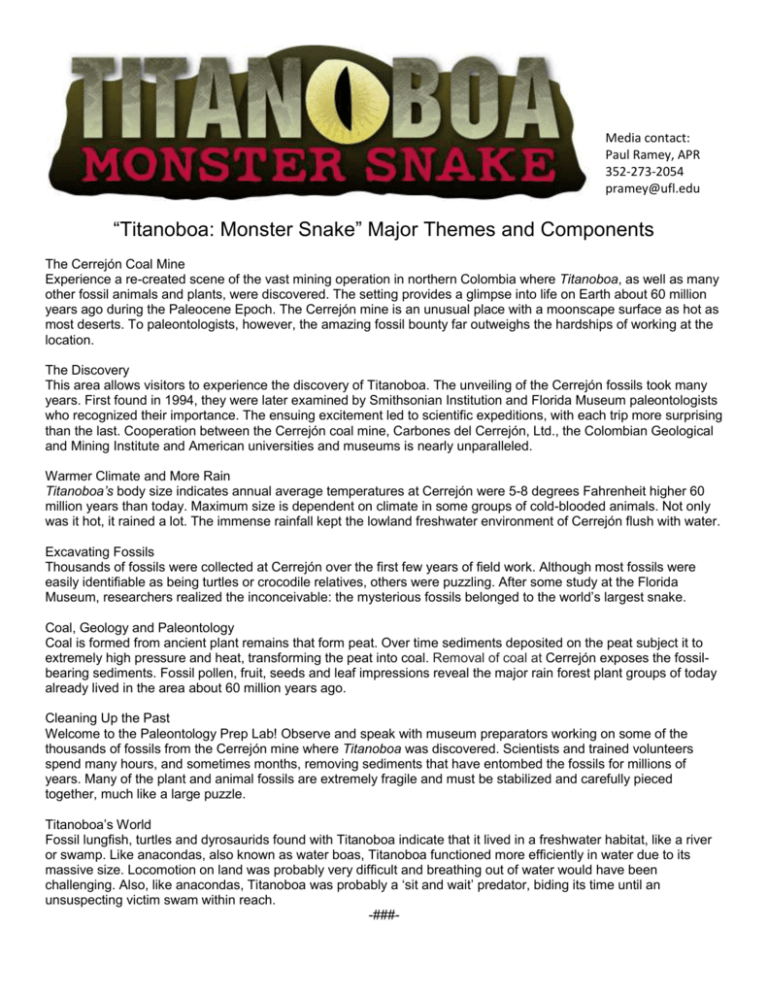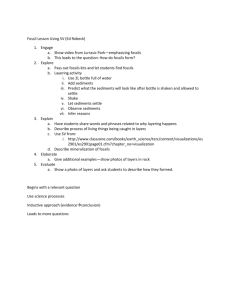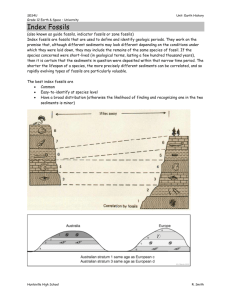Major themes and components
advertisement

Media contact: Paul Ramey, APR 352-273-2054 pramey@ufl.edu “Titanoboa: Monster Snake” Major Themes and Components The Cerrejón Coal Mine Experience a re-created scene of the vast mining operation in northern Colombia where Titanoboa, as well as many other fossil animals and plants, were discovered. The setting provides a glimpse into life on Earth about 60 million years ago during the Paleocene Epoch. The Cerrejón mine is an unusual place with a moonscape surface as hot as most deserts. To paleontologists, however, the amazing fossil bounty far outweighs the hardships of working at the location. The Discovery This area allows visitors to experience the discovery of Titanoboa. The unveiling of the Cerrejón fossils took many years. First found in 1994, they were later examined by Smithsonian Institution and Florida Museum paleontologists who recognized their importance. The ensuing excitement led to scientific expeditions, with each trip more surprising than the last. Cooperation between the Cerrejón coal mine, Carbones del Cerrejón, Ltd., the Colombian Geological and Mining Institute and American universities and museums is nearly unparalleled. Warmer Climate and More Rain Titanoboa’s body size indicates annual average temperatures at Cerrejón were 5-8 degrees Fahrenheit higher 60 million years than today. Maximum size is dependent on climate in some groups of cold-blooded animals. Not only was it hot, it rained a lot. The immense rainfall kept the lowland freshwater environment of Cerrejón flush with water. Excavating Fossils Thousands of fossils were collected at Cerrejón over the first few years of field work. Although most fossils were easily identifiable as being turtles or crocodile relatives, others were puzzling. After some study at the Florida Museum, researchers realized the inconceivable: the mysterious fossils belonged to the world’s largest snake. Coal, Geology and Paleontology Coal is formed from ancient plant remains that form peat. Over time sediments deposited on the peat subject it to extremely high pressure and heat, transforming the peat into coal. Removal of coal at Cerrejón exposes the fossilbearing sediments. Fossil pollen, fruit, seeds and leaf impressions reveal the major rain forest plant groups of today already lived in the area about 60 million years ago. Cleaning Up the Past Welcome to the Paleontology Prep Lab! Observe and speak with museum preparators working on some of the thousands of fossils from the Cerrejón mine where Titanoboa was discovered. Scientists and trained volunteers spend many hours, and sometimes months, removing sediments that have entombed the fossils for millions of years. Many of the plant and animal fossils are extremely fragile and must be stabilized and carefully pieced together, much like a large puzzle. Titanoboa’s World Fossil lungfish, turtles and dyrosaurids found with Titanoboa indicate that it lived in a freshwater habitat, like a river or swamp. Like anacondas, also known as water boas, Titanoboa functioned more efficiently in water due to its massive size. Locomotion on land was probably very difficult and breathing out of water would have been challenging. Also, like anacondas, Titanoboa was probably a ‘sit and wait’ predator, biding its time until an unsuspecting victim swam within reach. -###-





